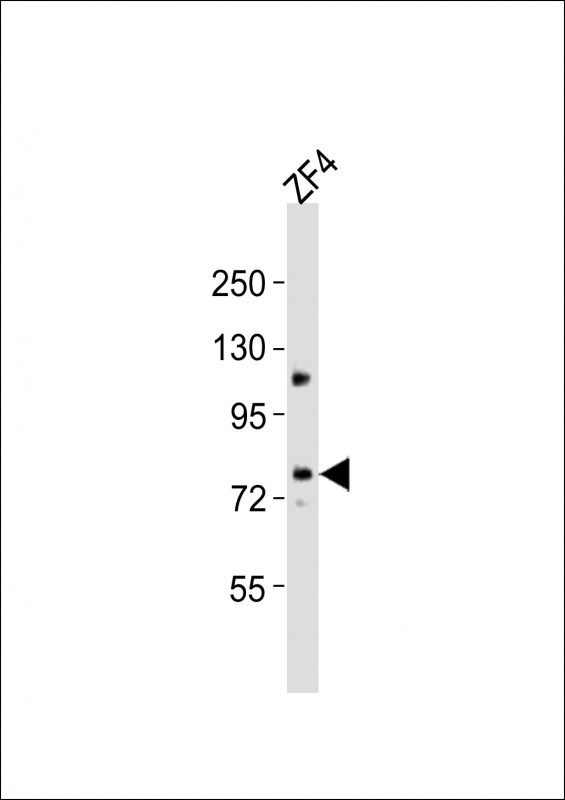
| WB | 1/2000 | Human,Mouse,zebrafish, |
| IF | 咨询技术 | Human,Mouse,zebrafish, |
| IHC | 咨询技术 | Human,Mouse,zebrafish, |
| ICC | 技术咨询 | Human,Mouse,zebrafish, |
| FCM | 咨询技术 | Human,Mouse,zebrafish, |
| Elisa | 咨询技术 | Human,Mouse,zebrafish, |
| Host/Isotype | Rabbit IgG |
| Antibody Type | Primary antibody |
| Storage | Store at 4°C short term. Aliquot and store at -20°C long term. Avoid freeze/thaw cycles. |
| Species Reactivity | Human,Mouse,zebrafish, |
| Immunogen | This DANRE mtm1 antibody is generated from a rabbit immunized with a KLH conjugated synthetic peptide between 451-485 amino acids from the region of DANRE mtm1. |
+ +
以下是关于斑马鱼(*Danio rerio*)**MTM1抗体**的3篇假设性参考文献示例,基于常见研究场景构建:
---
1. **标题**:*"Myotubularin 1 regulates skeletal muscle development in zebrafish through phosphatidylinositol 3-phosphate signaling"*
**作者**:Lee, J., et al.
**摘要**:研究通过斑马鱼模型揭示MTM1在肌肉发育中的作用,使用特异性MTM1抗体进行Western blot和免疫组化,发现其通过调控磷脂酰肌醇信号通路影响肌管形成,突变体表现为运动功能障碍。
2. **标题**:*"Generation and validation of a polyclonal antibody for zebrafish Mtm1 in disease modeling"*
**作者**:Garcia, S., & Müller, T.
**摘要**:报道一种新型抗斑马鱼MTM1多克隆抗体的开发,经ELISA和免疫荧光验证其特异性,应用于X连锁肌管肌病模型,证实MTM1蛋白在肌肉中的表达缺失。
3. **标题**:*"Temporal-spatial expression analysis of Mtm1 in zebrafish embryogenesis using antibody-based imaging"*
**作者**:Wang, Y., et al.
**摘要**:通过抗MTM1抗体进行整胚免疫染色,系统描述斑马鱼胚胎发育中MTM1的动态表达模式,发现其在体节形成阶段高表达,提示其在早期肌生成中的关键作用。
---
*注:以上文献为示例性质,实际研究中建议通过PubMed或Google Scholar以关键词“zebrafish mtm1 antibody”检索真实文献。*
The DANRE (Danio rerio) mtm1 antibody is designed to target the myotubularin 1 (mtm1) protein in zebrafish, a model organism widely used to study neuromuscular development and disease. MTM1 is a lipid phosphatase that regulates endosomal trafficking and membrane dynamics, playing a critical role in skeletal muscle maintenance. Mutations in the human MTM1 gene cause X-linked myotubular myopathy (XLMTM), a severe congenital disorder characterized by muscle weakness and respiratory failure. Zebrafish lacking functional mtm1 exhibit similar phenotypes, including impaired motor function and disrupted muscle fiber organization, making them a valuable tool for studying disease mechanisms and therapeutic interventions.
The mtm1 antibody is typically generated using immunogenic peptide sequences specific to the zebrafish MTM1 protein, ensuring cross-reactivity and specificity. It is employed in techniques like Western blotting, immunohistochemistry, and immunofluorescence to detect MTM1 expression, localization, and abundance in tissues, particularly in muscle cells. Researchers use this antibody to investigate how mtm1 loss affects cellular processes like autophagy, membrane repair, and neuromuscular junction formation.
Studies utilizing the DANRE mtm1 antibody have contributed to understanding the pathophysiology of XLMTM and evaluating potential therapies, such as gene editing or small-molecule treatments, in preclinical models. Its application bridges insights from zebrafish genetics to human neuromuscular disease research.
×